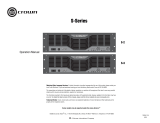
Indications shown on the Status Monitor are:
POWER ON: The amplifi er turn on status.
HI POWER: When on Dual Power is in Hi Power mode, if turned off it means it is in Hi Current mode.
In the case of wrong fuse positioning, master protection activates.
FAN ON: Cooling system is active.
TEMP GOOD: If solidly illuminated, it indicates the best operating temperature for maximum listening pleasure; if it blinks,
please wait.
LEFT CH: If it blinks intermittently, the left fan is active. Intermittence can vary depending on the three levels of fan speed.
If it doesn’t blink, it means that left channel has gone in protection mode.
RIGHT CH: Same operation as left channel.
BATT PRT: Protection activated because battery voltage is lower than 11 V or higher than 16 V.
THERM PRT: Thermal protection is on at 90°C ( 194° F) .
CHECK SPK: One output is in short circuit state with the car chassis. Check loudspeakers and cables.
SAFETY PRT: A certain protection is on. Check the other leds to identify the cause.
CHECK FAN: One of the four side heatsink fans or the drivers central fan is not functional. Check fans and air pathways.
SERVICE: The amplifi er is faulty, please go to the nearest after sales service centre.
LEFT (VUmeter): It indicates the signal level on Left output.
RIGHT (VUmeter): it indicates the signal level on Right output.
PEAK (VUmeter L/R): It reveals the amplifi er’s distortion limit. It usually turns on when the VUmeter is fully on, indicating
Clipping mode. It may occasionally turn on, but if on solid, power needs to be reduced. If it turns on when VUmeter isn’t
fully on, there must be anomalous distortion. Possibly the applied load is too high (low impedance) or has anomalies.
g) Lighting system
For cosmetic effect, the HV venti is equipped with three styles of lighting: the Thesis logo and glass perimeter red, the
Audison logo blue, and the internals of the amplifi er are lit white.
If the user removes the glass top plate, there are no electric wires to disconnect or reconnect, as electric contact
automatically occurs through spring loaded contacts; the white light for the internals are the result of various white
coloured LEDs.
In order to avoid current consumption, near the battery terminal connections on the amplifi er, there is a LIGHT ON-GND
terminal. If you connect this terminal to the car chassis, all the internal lights turn on. You can also control the internal
lights remotely through a switch. You could also connect the terminal to the trunk light ground switch so when the trunk is
opened the amplifi er lighting comes on.
Near this connection, there is a DC terminal to connect a small external 600 mA, 12 V power supply to turn on all the
internal lights, including the Status Controller. In this case the ACS activates in the demo mode. This function is useful for
exhibitions and doesn’t require the LIGHT ON-GND terminal to be connected to the car chassis.
4 • CHASSIS AND THERMAL PROJECT
The HV venti was designed to dissipate the heat generated by the amplifi er, and to make the system thermally stable.
Generally speaking, the system consists of a 5 mm thick aluminium plate that connects to two side cooling ducts; on the
top of the amplifi er two fans are placed at the end of each side. One pulls the air in, the other pushes it out, thus creating
a fl ow inside the underlying tunnel.
The aluminium plate bears all the various internal parts and also acts as heat-gathering element: internal heat generating
parts such as transformers and the energy management modules are attached to this plate.
This solution not only helped to eliminate the high heat generated by the HV venti internal circuits class “A” biasing,
but it also allowed excellent circuitry layout, by not forcing the designers to place the biggest heat sources next to side
heatsinks.
As well, as explained in the previous section, all power wiring runs on a board underlying the main one and is electrically
connected to it through screws and soldered bushes; this two layer thick copper power board is in touch with but electrically
insulated from the bottom plate: as a result, the whole power layout exhausts heat through the side ducts.
We turned to a different solution for the drivers and preamplifi er section.
The side ducts prevent the temperature from overcoming certain values but are nevertheless affected by the environmental
temperature and the time needed to reach the best working temperature. Instead, the drivers and preamplifi er circuitry
needs constant temperature.
In order to solve the concern, a further small tunnel for the central cooling system was designed. This tunnel is internally
combined with a fi fth autonomous fan.
- 7 -
DESCRIPTION
INTRODUCTION
2

























